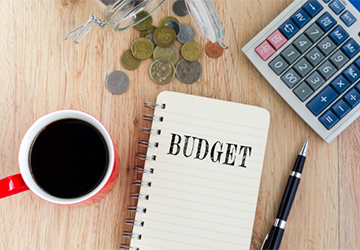Crafting a Family Budget A Comprehensive Guide
Creating a family budget may seem complicated, but it is one of the most critical steps to achieving financial independence and security. A well-designed budget can make all the difference when saving for a dream vacation, preparing for your child's education, or managing your daily expenses.

This article will walk you through the necessary steps to create a family budget that meets your needs. From setting realistic financial goals to tracking your spending patterns, we provide practical advice and strategies to help you manage your family's finances confidently and efficiently.
So, let's get started with this guide to family budgeting tips.
What are the Steps to Creating a Family Budget?
● Step 1: Understand Your Finances
Income
To calculate your family's monthly net income, determine each paycheck's net (after-tax) amount. Look for the net paycheck on your payslip or online bank statement. Once you have the after-tax income from all your income sources, add them together to arrive at your family's total monthly net income.
Expenses
There are two types of expenses: fixed and variable. Fixed costs like rent, mortgage, and extras stay the same monthly, while variable expenses like groceries, entertainment, and dining out fluctuate. Tracking your monthly spending can help you better understand your spending habits. Many apps and spreadsheets can make it easier to track your spending and give you a clearer picture of where your money is going.
● Step 2: Set Financial Goals
Financial goals are like roadmaps - they guide you to make the spending and saving decisions that matter most. Clear goals make your financial plan meaningful, whether it's your dream vacation for next year or saving for your child's college.
By setting clear short-term and long-term financial goals, you can create a sense of direction and momentum for your financial journey.
● Step 3: Create a Budget
Now comes one of the most critical steps in creating a household budget: it's time to create a budget, a roadmap for spending and saving. Here's how it works:
● 50% Necessities: Allocate half of your income to basic expenses you can't live without, such as rent, groceries, utilities, and transportation.
● 30% Aspirations: This category includes discretionary spending on entertainment, dining out, hobbies, or subscriptions.
● 20% Savings/Debt Paydown: The remaining 20% goes toward building an emergency fund, saving for a goal, or paying down debt.
Remember, this is a starting point. You can adjust these percentages based on your financial situation. The key is to meet your needs and then use the remaining funds to achieve your goals and desires. Choose the method that works best for your tracking and planning style.
● Step 4: Track and Adjust
Your budget is not set in stone, but tracking your spending habits is essential to staying on track. Budgeting apps and spreadsheets can make this process easier by allowing you to compare your actual spending to your budgeted amounts.
Review your budget regularly, weekly, or monthly. This will help you identify areas where you may need to spend less or less. Are there unexpected expenses? You should be more accurate in your assessment of the cost of food. Adjust your budget accordingly to reflect your actual spending habits.
What are Your Best Tips for a Family Budget?
Using the following points and our guide to family budgeting tips, you can create a budget to help you achieve your financial goals.
Track Your Income and Expenses
This is the first step to understanding where your money is going. You can track your income and expenses using a spreadsheet, a budgeting app, or pen and paper. You can adjust your budget once you know where your money is going.
Set Financial Goals
What are you saving money for? Do you want a new house, a dream vacation, or your child's college education? Setting financial goals will help you stay motivated and stick to your budget.
Create a Budget
There are many ways to create a budget, so find one that works for you. One popular method is spending 50% of your income on wants (housing, food, transportation), 30% on needs (entertainment, eating out), and 20% on savings and debt.
Stick to Your Budget
This is the hardest part, but spending discipline is essential. Sometimes, you want to treat yourself, but you should stick to your budget.

Review Your Budget Regularly
Your budget is not a static document. Review it regularly and adjust it if necessary. For example, if your income or expenses change, you must adjust your budget accordingly.
Communicate with Your Family
If you have a family, discussing your budget with them is essential. Explain your financial goals and how each person can help achieve them.
Find Ways to Save Money
There are many ways to save money on everyday expenses. For example, you can cook more at home, eat out less, and look for the cheapest deals and discounts.
What are the Benefits of a Family Budget?
Here are some of the key benefits of effective family budget planning:
Financial Clarity
A budget clearly shows your income and expenses. You'll see where your money is going and identify areas where you can save or save more.
Control and Security
A budget puts you in control of your finances. You can ensure greater financial security by making wise spending decisions and avoiding unnecessary debt.
Achieve Your Goals
A budget helps you set financial goals, such as B. saving for a vacation or college fund. By allocating your income to these goals, your spending will be more targeted and increase your chances of achieving them.
Less Stress
A budget helps relieve this stress by giving you a financial roadmap. You know you plan to pay for expenses and save for the future.
Improve Communication (for Families)
You create a budget together as a family, encouraging open communication about money. Everyone can participate in setting goals and tracking expenses, leading to a more consistent approach to your finances.
Conclusion
Creating a family budget allows you to take control of your finances. You can set goals that motivate spending and spend your hard-earned money on the things that matter most. A well-designed budget is not just about numbers; it's about achieving financial security and peace of mind. With effective family budget planning, you'll be better able to handle unexpected expenses, make smart financial decisions, and achieve your long-term goals.





